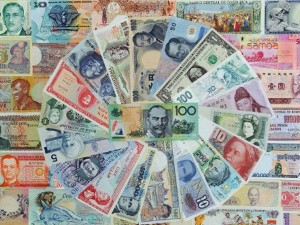Foreign reserves up 11% to $76B in April

The Philippines’ gross international reserves hit $75.97 billion as of end-April 2012, up by 11 percent from last year, the Bangko Sentral ng Pilipinas said Monday, May 7, 2012. AFP PHOTO
The country’s foreign exchange reserves rose to nearly $76 billion by end-April from a year ago as remittances and inflows remained robust, the Bangko Sentral ng Pilipinas reported Monday.
Data from the BSP showed that the gross international reserves (GIR) hit $75.97 billion by the end of April—rising by 11 percent from the $68.49 billion reported in the same period last year.
But compared with March, April’s figure came in slightly lower as the government paid off some of its foreign debts while the value of the central bank’s gold holdings declined based on the prevailing metal prices in the world market, the BSP said in a statement. As of last month, gold accounted for $10.4 billion of the central bank’s reserves.
In March, the GIR stood at $76.13 billion.
Also in April, the country for the third straight month marked a decline in its foreign exchange reserve.
Still, monetary officials said the remittances so far this year were on track of projections, posting a 5-percent growth from last year’s $20.1 billion as international demand for Filipino workers remained strong.
The central bank expects reserves to climb to a record $79 billion at the end of 2012.
Also, the country’s balance of payments surplus may narrow down to $2.8 billion, or 1.1 percent of gross domestic product, this year, from $10.18 billion in 2011, BSP officials said.
Apart from remittances, investments in the country’s business process outsourcing sector and foreign portfolio investments are considered to be drivers of the country’s foreign exchange reserves.
The BSP said the country’s latest GIR would be enough to cover 11.4 months of the country’s imports, and 6.4 times the Philippines’ foreign debts maturing over the short term.
According to central bank officials, the country has a comfortable GIR level, indicating its ability to fully service obligations to foreign creditors.
Foreign exchange reserves worth at least four months of imports are considered healthy based on international benchmarks.
In recent months, the Philippines has been pitching for an upgrade in its credit ratings, as economic officials claim significant improvement in the country’s credit-worthiness over the years.
The rising GIR and the government’s declining debt burden point to an improvement in the country’s credit standing, finance officials said, claiming that the Philippines deserves a rating upgrade.
Currently, the country is rated two notches below investment grade by Moody’s Investors Services and Standard & Poor’s, and a notch below investment grade by Fitch Ratings.—With a report from Reuters














